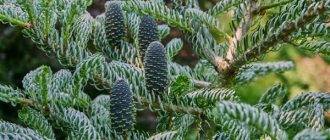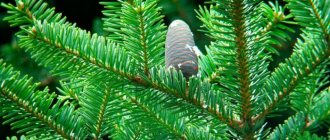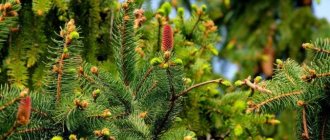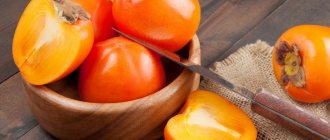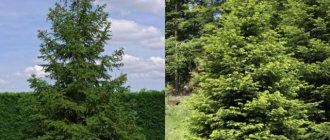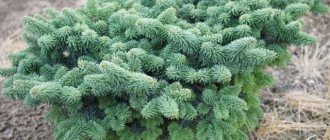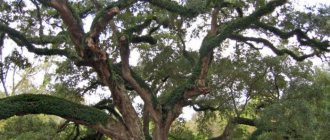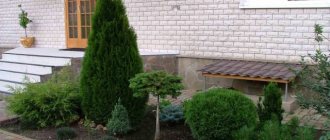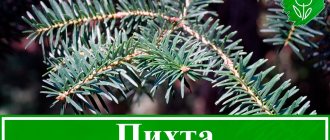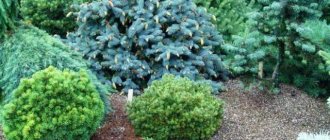Botanical description and characteristics of the species
The Latin name for this type of fir is Abies Nordmanniana. The tree belongs to the Pinaceae family and was named in honor of botany professor Alexander von Nordmann, who first described it in 1835–1836.
Did you know? The age of a fir can be determined by the branches of the tree. The annual growths on them grow in separate tiers, and every year a new “floor” is formed.
Description and characteristics of fir:
- The height of adult specimens is about 50 m, and the width of the crown reaches 7 m. Every year the tree grows by about 15 cm.
- The root system is taprooted and powerful, penetrating deeply into the soil.
- The diameter of the gray trunk can reach 2 m. Young trees have smooth bark, but with age, cracks appear on it.
- The shoots are yellow or light brown, quite soft. The elastic wood has a white-red color.
- The buds are ovoid, brown in color. There is almost no resin on them.
- The branches form a cone-shaped or pyramidal crown of regular shape, which descends to the ground.
- The length of flat fir needles is 2–4 cm, and the thickness does not exceed 1 mm. They have a blunt top and densely cover the branches.
- The color of the needles depends on the plant variety and can be green, golden, bright emerald or gray-bluish. The upper surface of the needles is glossy, and two white stripes are visible on the lower surface.
- Fir begins to bloom and bear fruit from the age of 30–70 years (depending on the variety). The flowering period falls in May, and pollination is carried out by the wind.
- Male inflorescences are red and shaped like spikelets. Female flowers grow at the top of the crown and are green oval earrings.
- The cones are directed upward, their length is 10–20 cm, and their width is up to 5 cm. Young fruits are green in color, and after ripening they turn brown.
Meaning
Nordmann fir has excellent decorative qualities. In particular, in this regard it is superior to European fir. Its foliage is thicker and more lush. in addition, the crown goes down to the ground, making the result look much better decoratively.
In economic terms, Nordmann fir is of great importance. Firstly, it forms both independent forests and mixed ones (with beech). Moreover, beech often grows better next to it and suffers less from various diseases. It is likely that this is directly related to the substances that many coniferous plants emit into the air. They are able to kill pathogens.
For the same reason, such vegetation is preferable in the resort area and around boarding houses. In Crimea, for example, thickets of Nordmann fir, along with juniper and spruce trees, are considered an excellent place for walking. Visiting such thickets is especially recommended for those who suffer from problems with the respiratory system.
But if we return to the topic of economic importance, it is worth noting that mixed forests are characterized by high productivity rates. On average, from 1 hectare of such plantings you can get from 700 to 1300 cubic meters of wood. And if the conditions for the growth of trees are favorable and the care is correct, then this number increases up to 2500.
However, the popularity of Nordmann fir is not due to this. First of all, it is needed to protect the soil. The root system significantly strengthens the soil. And in the process of life, fir also saturates the poor substrate with various substances useful for other crops.
In addition, this tree is also of great water conservation importance. It cleans internal waters quite well, which ultimately has a positive effect on the entire ecosystem.
Essential oil can be obtained from the bark and paws. In addition, the needles contain quite a lot of ascorbic acid, which partly explains the ability of this crop to resist pathogens.
Popular varieties
There are several varieties of Nordmann fir, which differ from each other in external characteristics. Each gardener can choose one of them depending on what composition he wants to create on his site.
Did you know? During the entire Caucasian expedition, Alexander von Nordmann collected a collection of 2000 names of plants and animals. As a reward for this achievement, Tsar Nicholas I personally awarded the scientist a diamond ring.
The most popular varieties of Caucasian fir:
- Golden Spider (Golden spreader). Representatives of this variety are distinguished by very slow growth - 10 years after planting, their height does not exceed 1 m. The needles are painted in an unusual golden-white color, and their length does not exceed 2 cm.
- Jadwiga (Jadwiga). These trees have fairly long but soft needles. The lower part of the needles is white, and the top is light green, which gives the variety a special decorative value. The crown below is formed by strong fluffy branches, and tapers towards the top, so it visually resembles a pear.
- Pendula (Pendula). The tree grows very slowly, forming an elongated silhouette. This variety is susceptible to unfavorable climate conditions, but has a particularly original weeping crown shape.
- Borjomi (Borjomi). Representatives of this variety are grown mainly in regions with warm climates. A special feature of the tree are its cones, which have a purplish-violet color.
- Hunnewell (Hunnewell). A dwarf variety, the maximum height of which does not exceed 70 cm. The needles have a rich silver-green color with a bluish tint.
Where does Nordmann fir grow?
Caucasian fir received its second name precisely because of its natural growth area. The western slopes of the Caucasian ridge are a place where fir still forms huge tracts. It is found mainly at altitudes from 900 to 2100 m in the republics of the Russian Caucasus, as well as in the countries of Transcaucasia: Georgia, Abkhazia, Armenia, Turkey.
Mixed plantings are formed mainly with beech and oriental spruce. The climate in these areas is characterized by high rainfall, relatively mild winters and not too hot summers.
These are the conditions in Europe that are typical for the maritime climate of Denmark, where cultivated varieties of Caucasian fir have been successfully grown for more than 100 years and sold before Christmas and New Year to all European countries.
But in the conditions of central Russia, Caucasian fir may not feel the best. Therefore, in the Moscow region, growing Nordmann fir may be associated with some difficulties, which, however, are quite surmountable with a strong desire.
Landing
It is better to plant this coniferous crop in spring or September so that the tree has time to take root before frost. It is recommended to grow Nordmann fir in sunny areas, but it can also grow in partial shade . The root system of the plant develops well in light and nutritious soil containing a sufficient amount of moisture. In the fall, it is necessary to dig up the soil in the chosen place to destroy the pest larvae overwintering in it.
It is better to purchase planting material from nurseries, giving preference to Premium seedlings with closed roots . Healthy specimens have soft and evenly colored needles without visible damage. Young trees that have reached the age of 5–7 years take root better in open ground.
Important! Nordmann fir has a developed root system, so it is recommended to plant it at a distance of at least 3 m from other trees and buildings.
Step-by-step landing instructions:
- Dig a planting hole about 60 cm in diameter and up to 80 cm deep, leaving it for at least 14 days for the soil to settle. When planting several trees, leave a distance of at least 2.5 m between them.
- Prepare a nutritious soil mixture to fill the hole. It should contain 15% river sand, 15% humus, 40% peat and 30% clay.
- Add a little complex fertilizer for coniferous crops to the resulting substrate.
- Place gravel or crushed stone at the bottom of the planting hole. The thickness of the resulting layer should be about 10 cm.
- Sprinkle some of the nutritious soil mixture prepared earlier onto the drainage. Form it into a small hill.
- Lower the roots of the seedling into the hole so that the root collar is level with the ground surface. Sprinkle the hole with the remaining nutrient substrate.
- Drive a vertical support next to the fir and tie a seedling to it.
- Water the tree with warm water. If planting was done in the spring, then shade the fir with non-woven material to protect it from sunburn and speed up rooting.
- Mulch the ground around the trunk with wood chips or dry conifer bark.
Features of cultivation
Growing a seedling from seed is a complex process. In order for the seed to sprout, you need to create natural wintering conditions for it. The grains are placed in the ground, making holes on top to allow oxygen to enter, then the containers are placed in a cold place. After two months, the seeds are germinated. They grow very slowly even with very good care. Therefore, experts recommend immediately purchasing seedlings in specialized stores. It is better if the tree is 5-10 years old. At this age, it adapts more easily to new conditions.
The distance between trees must be at least 2.5 meters
To choose a suitable place for a seedling, you need to follow the following rules:
- It is better to choose an open area that is not blocked by the branches of other trees.
- It is necessary to first apply fertilizer to the soil.
- If fir trees already grow on the site, then the distance between the trees should be at least 2.5 meters.
Fir care
For normal growth, the tree needs moisture and nutrients, so watering and fertilizing play a key role in fir care . In addition, you need to pay attention to measures to care for the soil around the plant and the organization of winter shelter when growing crops in areas with a cold climate. Compliance with these rules of care will prevent the appearance of diseases and pests, but if this does happen, then take the necessary actions to eliminate the problem.
Video: How to properly plant and care for fir
Watering and fertilizing
Seedlings can dry out due to lack of moisture in the soil, so they need to be watered. But it is impossible to over-moisten the soil, as this leads to the appearance of diseases and harms the tree.
Important! After the tree reaches adulthood, you can refuse to apply fertilizers, since the powerful root system receives all the necessary nutrients from the soil.
Basic rules for applying fertilizers and irrigating crops:
- During the first year after planting a young tree, watering is carried out regularly as the soil around the trunk dries;
- They begin to irrigate the plants in early spring - this helps them awaken after the winter dormancy period;
- during drought, mature trees are watered 2 times a week, and with sufficient rainfall and moderately warm weather - about 2-3 times throughout the season;
- in hot weather, you can additionally spray the crown with warm water - this procedure is carried out early in the morning;
- to feed young seedlings in March, 40 g of nitroammophoska are added per 1 m² of area;
- It is enough to carry out spring feeding of mature trees once every 3 years, using ready-made fertilizers for coniferous crops (for example, Kemiru-universal).
Loosening and mulching
The fir root system responds well to surface loosening of the soil . This procedure facilitates access of oxygen, water and fertilizers to the underground part of the tree, and also helps to destroy pest larvae. Loosening must be carried out in autumn and spring, and weeds around the trunk are also periodically destroyed.
You can keep the area of the Nordmann fir tree trunk moist and loose for a long time using mulching . To do this, the surface of the ground near the tree is sprinkled with dry pine bark or wood chips. The thickness of the mulch layer is usually 5–7 cm.
Did you know? In Europe, fir is placed at home for Christmas instead of Christmas trees and pine. This popularity is explained by the fact that the tree’s needles do not fall off for a long time even after it is cut down.
Trimming
The crown of the Nordmann fir has the correct shape, so it looks beautiful on the site even without pruning . The exception is dried and broken shoots - they must be removed in early spring using sharp pruning shears. If some tree branches have been damaged by frost, they should be pruned at the end of May, when the likelihood of late frosts disappears.
How long does it take to grow
In terms of development speed, the tree is classified as a slow-growing tree, reaching 10 m in height by the age of 30. The total lifespan of Caucasian fir can be about 500 years . The age of some specimens of this type of coniferous crops reaches 700 years.
Did you know? Denmark is the largest exporter of Christmas trees in the world. For this purpose, about 12 million coniferous crops are grown here annually.
Preparing for winter
Nordmann fir grows best in regions with warm summers and moderately cold winters , so when cultivating the plant in a more severe climate, care must be taken to provide shelter. Mature trees can tolerate frosts down to –30°C, but young trees begin to freeze already at –15°C.
To prepare fir for wintering, perform the following steps:
- the tree trunk area is mulched with peat or dry wood chips, forming a layer of 10–12 cm;
- branches of young trees are wrapped in non-woven material, removing it only after the onset of consistently warm weather - adult specimens need such shelter only in frosts below –25°C;
- small seedlings are additionally covered with spruce branches on top.
Nordmann fir (Danish fir tree) in landscape design
Over the past decades, coniferous trees have taken a strong place in landscape design. After all, they delight the eye with their green color all year round, and the pine aroma can purify the air and bring harmony to the nervous system.
The natural variety of Caucasian fir, due to its massive size, is more suitable for large areas as a tapeworm or for decorating gardening areas. For medium-sized areas, it is wiser to use dwarf varieties of this fir bred by breeders. They will serve as a decoration for both the rocky garden (alpine hill) and the courtyard area.
Possible diseases and pests
The tree exhibits stable immunity to diseases and pests, but becomes vulnerable if care recommendations are not followed. Excessive watering has a particularly adverse effect on the plant, which leads to fungal infections.
Find out more about the treatment of fir diseases and pest control.
The main diseases and pests of Nordmann fir:
- Rust. The causative agent of the disease is a fungus, and the main symptom is orange blisters on the needles. The tree's needles begin to turn yellow and dry out, which can lead to the death of the shoots. The affected areas are removed with pruning shears, treating the cut areas with garden varnish. The crown is sprayed with a 1% solution of Bordeaux mixture or the Abiga-Peak preparation.
- Brown Schutte. The infection is fungal in nature and appears in early spring. At the same time, you can notice a thick black-brown coating on the tree needles, which provokes yellowing and wilting of the needles. The diseased specimen is treated with Oxychom, having previously removed all infected areas.
- False shield. The insect feeds on tree sap, causing the needles to dry out. Honeydew appears on the shoots, which is the result of the life activity of the pest. The false scale insect is cleaned from the branches with a brush, and special traps with insect glue are installed on the tree.
- Spider mite. The pest envelops the fir in a thin web, causing the needles to turn yellow. Over time, the needles turn brown and the tree dries out. You can get rid of ticks using the Actellik acaricide by spraying the crown with it according to the instructions.
- Hermes. Its appearance on fir is indicated by a white coating on the surface of the needles. If the damage is minor, all infected areas should be cut off and burned. You can get rid of the pest using the special drug Fufanon.
To prevent infection, it is recommended to follow these simple preventive measures:
- use high-quality planting material;
- adhere to the planting scheme;
- follow watering and fertilizing schedules;
- loosen the soil in the tree trunk area;
- carry out sanitary pruning annually;
- It is good to cover young trees for the winter.
Important! When preparing and applying the working solution of fungicides and insecticides, you must wear rubber gloves and a respirator. Spraying is carried out in dry and windless weather.
Norman fir for the New Year
Even more often, Nordmann fir is sold before the New Year or Christmas in the form of a cut tree in special stores or at Christmas tree markets. Thanks to its luxurious appearance, it became very popular. And many, calling it Norman fir in their reviews, do not even suspect that under natural conditions this tree grows in Russia.
How to preserve Nordmann fir for the New Year
These trees are much better suited for home decoration for the New Year than spruce or pine trees. There are several reasons for this:
- have an almost ideal cone shape with dense foliage;
- the needles have a rich green color, are soft and do not prick at all;
- They can delight you with green and fresh pine needles in a room for up to several months.
In order for the Nordmann fir to stand longer and please the eye with its green and fluffy appearance, it is advisable to follow the following rules:
- Trees are purchased at street markets, where the air temperature allows them to be preserved for a longer time.
- Place the tree trunk in a bucket of water or wet sand, adding a few tablespoons of glycerin, which can be bought at any pharmacy, to the water.
- Do not use paper toys to decorate fir, since for longer preservation it is advisable to spray it every day with a spray bottle.
How long does it take for Nordmann fir to fall off?
After cutting, Nordmann fir needles can remain green for up to 10 weeks. But since no one knows exactly when it was cut down, in any case there is only about a month to two left. This is a long time. Almost no coniferous tree retains its needles for so long.
Does Nordmann fir smell?
The needles of the natural type of Caucasian fir are very fragrant and can fill the house with the smell of a coniferous forest for a long time. But specimens of cultivated varieties of this fir grown abroad do not smell at all, although they look magical. But they are usually sold everywhere before the New Year in most shopping centers.
So, if you want to get Nordmann fir with the smell of a real coniferous forest, you will have to go to a specialized Russian nursery to get it.
Reproduction methods
Nordmann fir can only be propagated by seeds . But it is quite difficult to carry out this process at home, because the germination percentage is very small.
Video: Fir propagation by seeds
To propagate this coniferous crop, you need to perform the following steps:
- In September, collect unopened cones to harvest planting material.
- Remove the seeds. Wrap them in paper towel and store in the refrigerator until the end of December.
- Conduct stratification of planting material. To do this, mix it with sand, wrap it in a damp cloth and put it in the refrigerator for 1-2 months.
- At the end of February, prepare a container with a loose soil mixture consisting of garden soil, sawdust and sand, taken in equal quantities.
- Plant the seeds in the container, deepening them into the soil by about 2 cm.
- Place the container in a sunny and warm place (+23°C). Periodically moisten the soil with a sprayer and carry out surface loosening.
Important! Sprouts obtained from seeds can be planted in a permanent place after 4 years. If transplanted earlier, the plants will not be able to take root and will die.
After sprouting in the summer, the container with the sprouts is taken out into the garden, shading the plants from bright sunlight . When the young shoots grow a little, they are planted in separate larger pots. In winter, containers with seedlings are buried in an open area, covering the sprouts with spruce branches.
How long does Nordmann fir grow?
But it is necessary to understand that Nordmann fir is still an outdoor plant and it will not be able to live and develop normally in an apartment indefinitely. Under the most ideal care conditions, she can survive at home for no more than 3-4 years. At the same time, it will need annual replanting, since during this period the root system develops much more intensively than the above-ground part. But then its size will still force it to be transplanted outside, otherwise the tree will simply dry out and die.
Attention! It is best to replant Caucasian fir in open ground in the spring before the buds open. It is better to accustom a tree to outdoor conditions gradually.
What place to choose on the site
Nordmann fir is a primarily partial shade plant, although it can withstand both shade and bright sun. Due to its well-developed and powerful root system, it is resistant to winds. It is demanding of clean air and does not tolerate gas pollution in cities and industrial areas; this must be taken into account when choosing a location. Nordmann fir is unpretentious, but still does not like to be disturbed. Therefore, the location on the site must immediately be chosen as permanent, so that later there are no numerous transfers. In its natural habitat, the tree grows quickly, but, for example, the Nordmann fir in the Moscow region will grow only 12-15 cm annually.
What are the advantages of container crops?
The root ball is preserved as a whole
This is extremely important for conifers. The fact is that on the roots of all coniferous plants, including fir, there lives a special microorganism - mycorrhiza, which helps plants absorb moisture and nutrients from the soil
When this microorganism dries out, it dies. If you are offered to buy a coniferous seedling with an open root system, then under no circumstances should you buy it. Most likely, such a tree will not take root.
The coniferous fir tree is a record holder for endurance and can withstand drought perfectly. However, it needs to be planted correctly so that it subsequently grows well and looks beautiful and fluffy. One of the first conditions for properly planting a fir is choosing a location. It should be well lit, sunny or, at least, light partial shade. The second condition is to correctly dig a hole in which to plant the fir.
Comments (2)
Mokina Sveta
02/01/2018 at 03:23 |
The Caucasian fir grew in front of our plot, but somewhere in the third/fourth year it dried up, no matter how hard we tried to care for it. Most likely it was hot for her there or the land did not suit her.Answer
Yulia Expert Plodogorod
08/24/2019 at 09:28 pm |
Hello, Mokina Sveta! Let's look at the main reasons why this could happen to your plant. Fir of this variety can grow both in shaded and well-lit areas. Wind also cannot cause significant harm to the plant.
But this conifer loves humidity. Therefore, it needs to be watered in a timely manner, and sometimes even sprayed. If your specimen did not grow in the garden, and care, especially watering, was difficult, this could cause disease and then death of the fir.
As for the soil, it must be well fertilized. This plant especially likes mineral products. The most suitable soil is loam. It should be noted that this crop can also develop in heavy, acidic soil, therefore, the condition of the soil must be very neglected for it to destroy the tree. If you took good care of it, most likely the quality of the soil did not play a significant role.
It is possible that the seedling that was purchased for planting was initially weakened or affected by some kind of infection. Also, if a drainage layer was not laid during planting, and the soil was still dense, root rot could be the cause of drying.
Sometimes the death of a plant is associated with an incorrect feeding regime. So, if you add nitrogen at the end of summer and in the fall, for example, in the form of organic matter, the tree, instead of preparing for the dormant season, will begin to actively develop. This will significantly reduce its winter hardiness and can lead to freezing even of cold-resistant crops.
Even if a particular variety of Caucasian fir is resistant to low temperatures, young seedlings must be carefully wrapped. We recommend using only breathable materials for this, such as agrofibre, so that the plant does not freeze.
In addition to errors during planting and care, the death of a plant can be caused by the appearance of pests. If, in addition to the drying of the needles and shoots on the plant, the resemblance of drops on the crown is noticeable, the reason may be an attack by false scale insects. If the infestation is not too severe, sticky traps can be used for control.
Also, drying and falling of needles is often provoked by an attack by spider mites. You need to carefully examine the needles for thin cobwebs. If this is the reason, you need to increase the humidity level near the plant and treat it with Actellik or Neoron.
To protect against harmful insects, it is worth removing garbage and litter, especially before wintering, and strengthening the immunity of conifers with potassium fertilizers.
Answer
Reviews
Reviews about nordmann fir are positive: the tree has a beautiful appearance and does not require special care. It is chosen for its tightly planted needles and intense color of the needles.
However, experts note that the crop is extremely sensitive to air pollution. Therefore, it is not recommended to plant it near big cities: in the same suburbs it may not feel well.
When using the Danish Christmas tree as a symbol of the New Year and Christmas, it is given only a positive assessment. The Nordmann fir does not fall off for a long time and looks “like something out of a fairy tale” thanks to its thick emerald needles and the correct shape of the crown.
Strong branches allow you to hang a large number of decorations on them, and the tree stands indoors without shedding its needles for up to 10 weeks from the moment of cutting. It should be remembered that it is best to buy it in nurseries: this way the price will be lower, and the plant will be of higher quality and fresher.
The only thing that confuses buyers is the price, which can reach 2000 rubles. But at the same time, many agree that the feeling of celebration and magnificent appearance are worth the money.
The soil
It is best to plant Nordmann fir, like other conifers, in early spring - April - or autumn, in September. The depth and width of the hole depend on the size of the seedling and its root system, but not less than 70 cm in depth and width. Nordmann fir is undemanding in terms of soil composition, but still prefers loamy and light-textured soils. For better survival, you can prepare the soil for planting yourself. To do this, you need to mix clay, humus, sand and peat in a ratio of 2:3:1:1. It is recommended to add mineral fertilizer. At the bottom of the hole, be sure to pour a 20 cm layer of drainage (brick chips, coarse river sand, pebbles, sawdust). It is advisable to make the distance between trees in a group planting 3-5 meters; plants will look good individually, and the dwarf form is allowed even in a flower bed.
